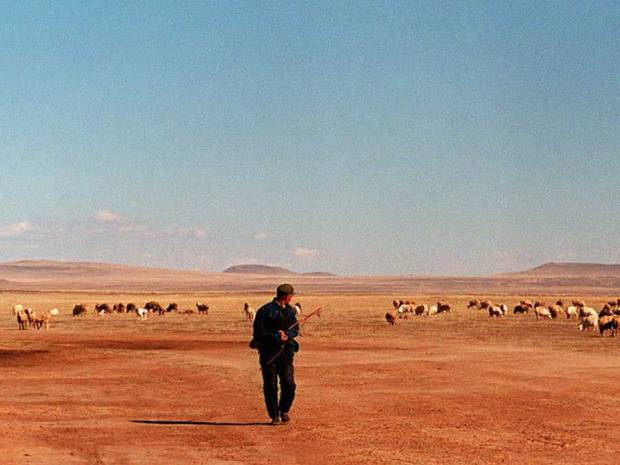| |
|
The
Independent |
|
April
5, 2013 |
|
By
Isobel Yueng -- A Chinese and reporter of China's
official news CCTV |
|
|
|
The 'tyrant China strikes
again' line isn't always applicable. We need more
perspective when looking at China's policies in the
autonomous region of Inner Mongolia
 |
|
|
A
herdsman tends his sheep on a barren pasture, in
An Zhe Li Mu 15 October. As domestic animals in
Inner Mongolia multiply quickly, the neglected
pasture land is degenerating fast and is
expected to become a desert within several
years. |
|
China
has developed a reputation for being an unforgiving bully
towards its 55 ethnic minorities. This is hardly surprising,
given the consistently repressive policies adopted across
the allegedly autonomous regions of Tibet and Xinjiang over
the last decade. Policies pushing these outer regions into
line with the rest of China have been damned by most,
including Ilham Tohti, an intellectual from
the
Uyghur ethnic group.
He describes the situation as "worse even than colonialism".
More recently though, the
previously media-shy autonomous region of Inner Mongolia,
with a minority population of around 5 million, has started
to gain attention. In 2011, the first large-scale unrest in
two decades broke out when a Mongolian herder was killed by
a coal truck driver, and last year there was further cause
for unease when protests against land seizure were brutally
suppressed near the city of Tongliao.
Several Mongolian minority human
rights groups have sprung up abroad as a result, including
the New York-based Southern Mongolian Human Rights
Information Centre. Such groups are where most media reports
derive their information from, and it therefore becomes
tempting to draw comparisons between Inner Mongolia and
other autonomous regions, reflecting a further example of
China's apathetic approach towards its minorities.
But I'd argue that this attitude
comes from an over-simplification of Inner Mongolia's
current economical, cultural, and environmental issues. The
recent discontent has arisen due to the authorities'
enthusiastic 'recovering grassland ecosystem' policy pursued
over the last few years, where previously nomadic
minorities, including Mongols and ten other minorities
residing in the region, are seen to have been be turfed off
their land by coal-hungry Han (the ethnic group which makes
up about 92 per cent of China's population). As a result,
they are jerked in to the glare of modernity, or worse still
made into rare museum pieces lamenting the loss of their
herds and grasslands, their unwritten languages and
practical skills.
These accusations are not
unfounded, as hundreds of thousands of minorities across the
region have been forcefully encouraged to move into
permanent homes on the outskirts of Han cities. However,
it's not these cultures that the government has purposefully
set out to destroy. It's their medieval lifestyles that are
incompatible with a developing China that is exploiting coal
mining opportunities, while simultaneously attempting to
reclaim mass amounts of land. China's number one concern is
economic prosperity, and
with Inner Mongolia's rich natural
resources, it now has the strongest economic
growth of China's five autonomous regions. At the same time,
the country now faces 2.6 million square-kilometres of
desertified land, in part due to more modern and
industrialising activities from Han farmers, but also thanks
to problems of overgrazing, logging, and expanding
populations, directly linked to animal husbandry lifestyles
favoured by the minorities.
Clinging on to a minority culture is not a priority, but
that's not to say that China's aim of a homogenised standard
of living across the country is wholly bad. Reports from the
area tend to focus on relocation schemes leading to the loss
of traditional lifestyles and struggles in adapting to a
modern world. Forty-two year old Bu Lie Tuo Tian of Ewenke
ethnicity (one of the four main minorities in the region),
who I met just outside Genhe city, reflected nostalgically
on life in Shangyang Ge Qi forest before her family was
relocated. "We were freer, we could hunt and move as we
pleased, and we felt at home when we were close to our
reindeer." More reluctantly acknowledged are the severe
issues with alcoholism, and the many stories of tribe
members freezing to death and mistakenly shooting each other
whilst out hunting bears (up till last year, when their guns
were unofficially confiscated).
From a modern day perspective, at least all of the
recently relocated minority groups have seen their prospects
significantly improve since their hunting days. The
government has not only provided chalet-style housing within
a tight-knit community, electricity, monthly welfare
payments and vastly improved infrastructure, but also fresh
opportunities in the recently revamped tourism industry.
When the topic of Bu's 17-year-old son is raised, both her
and her husband Xiao Liangku are regretful that their only
child has chosen to leave his grassroots behind and move to
the city to further his education, but at the same time,
there is a strong feeling of pride. They also know that if
their son is to make his mark, he must learn Mandarin and
embrace a Han lifestyle.
Reluctance to change and grief over dying cultures are
prevalent, and as ever the media is more than eager to
criticise China's human rights policies. But it's difficult
to say that these changes have been purely negative. It
seems to me like China is stuck between a rock and a hard
place when dealing with minorities here; condemned for
dragging them into modern China, but also condemned if it
leaves them behind. Iím not suggesting that their iron fist
approach is healthy, but perhaps its time to consider that
China too wants no child left behind. |





